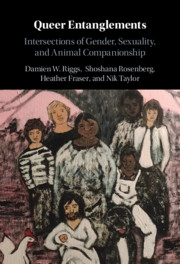Book contents
- Queer Entanglements
- Queer Entanglements
- Copyright page
- Contents
- Figures
- Acknowledgements
- Frontispiece
- 1 Menageries, Enmeshment, and Irreducibility
- 2 Love, Loss, and Grief
- 3 Violence, Cruelty, and Rescue
- 4 Sameness, Difference, and Intercorporeality
- 5 Rainbows, Flags, and Bridges
- 6 Consumption, Consumerism, and Kink
- 7 Voice, Responsibility, and Liberation
- References
- Index
4 - Sameness, Difference, and Intercorporeality
Published online by Cambridge University Press: 09 July 2021
- Queer Entanglements
- Queer Entanglements
- Copyright page
- Contents
- Figures
- Acknowledgements
- Frontispiece
- 1 Menageries, Enmeshment, and Irreducibility
- 2 Love, Loss, and Grief
- 3 Violence, Cruelty, and Rescue
- 4 Sameness, Difference, and Intercorporeality
- 5 Rainbows, Flags, and Bridges
- 6 Consumption, Consumerism, and Kink
- 7 Voice, Responsibility, and Liberation
- References
- Index
Summary
In this chapter, we problematise the simplistic assumption that change in regard to gender is made more tenable or positive for humans as a result of the continuity that animal companionship offers. Instead, we argue that animals are not passive recipients of human change. Rather, we suggest that animals are closely attuned to human change. In the context of gender transition, continuity is rendered far more complex than might be suggested by cisgenderist narratives circulating about transgender and non-binary people. Liberal accounts of gender transition suggest that ‘the person doesn’t change’. Yet animal responses to gender transition suggest that the person does change, even if the nature of the human–animal relationship remains constant. By considering human accounts of how animals engage with change in their lives, this chapter suggests that animal companions are active agents in the context of human gender transition, speaking to their own awareness of, and contribution to, human–animal relationships.
- Type
- Chapter
- Information
- Queer EntanglementsIntersections of Gender, Sexuality, and Animal Companionship, pp. 90 - 117Publisher: Cambridge University PressPrint publication year: 2021

